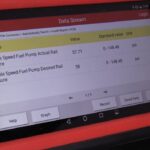Encountering an illuminated Malfunction Indicator Lamp (MIL), often referred to as a “check engine light,” in your 2003 Honda Odyssey can be concerning. If you’ve used an OBDII scanner and retrieved the code P1457, it indicates a problem within your vehicle’s Evaporative Emission Control System (EVAP). This article, tailored for English-speaking car owners and enthusiasts, will delve into the specifics of OBDII code P1457 for the 2003 Honda Odyssey, providing insights into its causes, symptoms, and potential fixes.
What is OBDII Code P1457?
OBDII code P1457 is officially defined as “Leak Detected in EVAP Control System (EVAP Control Canister System)”. This means the Engine Control Module (ECM) or Powertrain Control Module (PCM) has detected a leak within the part of the EVAP system associated with the vapor canister. The EVAP system is crucial for preventing harmful fuel vapors from escaping into the atmosphere. It captures these vapors and routes them back to the engine to be burned, contributing to both environmental protection and fuel efficiency.
When the system detects a leak, it triggers the P1457 code and turns on the MIL to alert the driver that there’s an issue requiring attention. In the case of the 2003 Honda Odyssey, a common culprit for this code is related to the EVAP bypass solenoid valve.
Symptoms of P1457 in a 2003 Honda Odyssey
The most obvious symptom of a P1457 code is the illuminated check engine light on your Honda Odyssey’s dashboard. However, you might not notice any other immediate drivability issues. Unlike some engine codes that cause rough running or stalling, P1457 primarily indicates an emissions system problem.
In summary, the main symptom is:
- Malfunction Indicator Lamp (MIL) or Check Engine Light is ON.
While less direct, a persistent P1457 code can potentially lead to:
- Failure to pass emissions tests: Because the EVAP system is not functioning correctly, your vehicle may fail an emissions test, which is a requirement in many regions.
- Slight decrease in fuel efficiency: Though often minimal, a leak in the EVAP system can sometimes lead to a minor reduction in fuel economy as vapors are lost rather than recycled.
Causes of P1457 in 2003 Honda Odyssey
According to a service bulletin specifically addressing this issue in Honda vehicles, including the 1999-2003 Odyssey, the probable cause of P1457 is often a failure of the EVAP bypass solenoid valve due to corrosion.
It is important to consult the specific service manual for the 2003 Honda Odyssey to pinpoint the exact location of the EVAP bypass solenoid valve. This image is for illustrative purposes and may not represent the exact component or location in your vehicle.
Here’s a breakdown of the cause:
- EVAP Bypass Solenoid Valve Failure: This valve can become corroded, particularly in regions where roads are salted during winter. Water, especially if it contains road salt, can enter the solenoid valve and cause the internal windings to corrode.
- Corrosion: The corrosion hinders the valve’s ability to function correctly. It may stick, fail to open or close properly, or become electrically non-functional.
- Electrical Short (Rare): In rare cases, severe corrosion can lead to an internal short circuit within the solenoid valve. This short can potentially damage the ECM/PCM.
Vehicles operated in areas with heavy road salt usage, such as the Northeastern United States, are more susceptible to this issue.
How to Diagnose and Fix P1457 on a 2003 Honda Odyssey
Diagnosing and fixing a P1457 code usually involves testing and potentially replacing the EVAP bypass solenoid valve. Here’s a step-by-step approach, drawing from the Honda service bulletin:
Tools and Equipment Needed:
- OBDII Scanner: To read and clear codes.
- PGM Tester (Honda Diagnostic System) or equivalent professional scan tool: For solenoid valve activation and system testing (Ideal, but basic testing can be done with multimeter).
- Multimeter: To check for voltage and continuity (if not using advanced scan tool).
- Basic hand tools.
- Service manual for 2003 Honda Odyssey (Recommended).
Repair Procedure:
-
Verify the Code: Use an OBDII scanner to confirm the presence of DTC P1457. Record any other codes present as well.
-
Access the EVAP Bypass Solenoid Valve: Locate the EVAP bypass solenoid valve. Refer to your Honda Odyssey service manual for the exact location. It’s typically found in the engine compartment or near the EVAP canister.
-
Initial Solenoid Valve Test (Using PGM Tester or Similar):
- Connect a PGM Tester (or equivalent) to the vehicle’s data link connector.
- Follow the tester’s menu to access the EVAP system tests and specifically the “Single Solenoids” test.
- Activate the EVAP bypass solenoid valve using the tester.
- Listen and Feel: Carefully listen for a “click” and feel for a slight “tap” from the solenoid valve when activated.
- If you hear and feel the click/tap: The solenoid valve might be functioning mechanically. However, it’s still possible for it to be faulty under certain conditions. Further testing might be needed or consider other potential causes for P1457.
- If you DO NOT hear or feel the click/tap: Proceed to the next step, as the solenoid valve is likely faulty.
-
Replace the EVAP Bypass Solenoid Valve:
- Disconnect the electrical connector from the solenoid valve.
- Remove any hoses connected to the valve, noting their positions for correct reassembly.
- Remove the solenoid valve from its mounting.
- Install the new EVAP bypass solenoid valve, ensuring all hoses and the electrical connector are securely reconnected.
-
Test the New Solenoid Valve (Using PGM Tester or Similar):
- Repeat step 3 to activate the new solenoid valve using the PGM Tester.
- If you now hear and feel the click/tap: The solenoid valve is likely functioning. Proceed to step 7.
- If you STILL DO NOT hear or feel the click/tap: There might be an issue with the wiring or the ECM/PCM. Proceed to step 6.
- Repeat step 3 to activate the new solenoid valve using the PGM Tester.
-
Check Wiring and Connectors:
- Inspect the wiring harness and connectors leading to the EVAP bypass solenoid valve for any signs of damage, corrosion, or breaks.
- Repair any damaged wiring or connectors.
- Re-test the new solenoid valve with the PGM Tester (repeat step 5).
- If it now works: Proceed to step 7.
- If it still doesn’t work: The ECM/PCM might be damaged (though rare). Proceed to step 7, but consider ECM/PCM replacement if issues persist.
-
Clear the DTC and Test Drive:
- Use an OBDII scanner to clear the P1457 code.
- Take the Honda Odyssey for a test drive to see if the check engine light comes back on.
- Ideally, perform an EVAP system function test using a PGM Tester or advanced scan tool to ensure the entire system is operating correctly.
-
ECM/PCM Replacement (If Necessary and as a Last Resort):
- If, after replacing the solenoid valve and checking the wiring, the P1457 code persists and the solenoid valve still doesn’t activate, ECM/PCM replacement might be considered, especially if there was suspicion of an electrical short. This is a rare step and should be done only after thorough diagnosis and preferably by a professional technician.
Parts Needed:
- EVAP Bypass Solenoid Valve: Refer to your Honda parts catalog for the correct part number for a 2003 Honda Odyssey. The service bulletin mentions P/N 17012-S01-A00 as a potential part number, but always verify with your parts supplier for your specific model.
- ECM/PCM (If Necessary): Part number will depend on your specific vehicle. Again, consult your Honda parts catalog. The service bulletin lists P/N 37820-P2P-A12 as a potential ECM/PCM part number mentioned in the bulletin for warranty claims on certain models – this is likely NOT the correct part for a 2003 Odyssey and is just an example from the original service bulletin related to potential ECM damage in rare cases across various Honda models, not specifically the Odyssey. Always verify the correct ECM/PCM part number for your 2003 Honda Odyssey.
Is it a DIY Fix?
Replacing the EVAP bypass solenoid valve is a repair that can be attempted by a moderately skilled DIYer with some mechanical experience and tools. However, accurate diagnosis, especially if the issue is not simply a faulty solenoid valve, may require professional diagnostic equipment.
Caution: Working with automotive systems requires care. If you are not comfortable with electrical testing or automotive repair, it’s always best to consult a qualified mechanic. Incorrect diagnosis or repair can lead to further issues. Also, be aware that in rare cases, the ECM/PCM could be damaged, which is a more complex and expensive repair requiring professional expertise.
Conclusion
OBDII code P1457 in a 2003 Honda Odyssey often points to a malfunctioning EVAP bypass solenoid valve, frequently due to corrosion. By understanding the symptoms, causes, and diagnostic steps outlined in this article, you can approach the issue with more clarity. While DIY repair is possible for solenoid valve replacement, don’t hesitate to seek professional help from a qualified mechanic to ensure accurate diagnosis and repair, especially if the problem is not straightforward or if you are not comfortable working on your vehicle’s emission system. Addressing this issue promptly will help keep your Honda Odyssey running efficiently and environmentally friendly.


